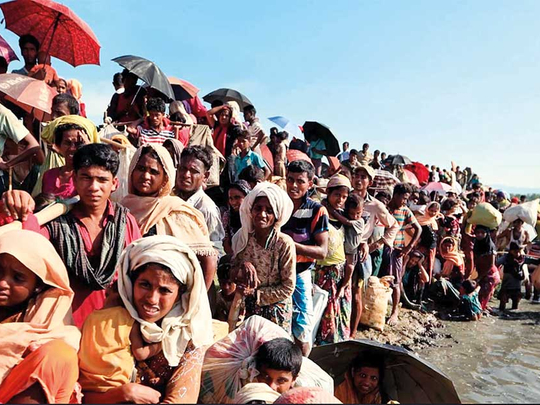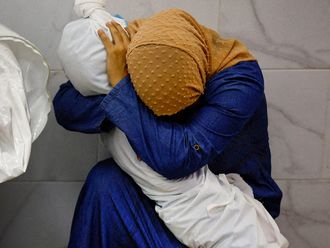
Dubai: Nearly 16.2 million people joined the displaced population around the world last year, raising the total number of displaced in 2017 to a new record high of 68.5 million people, a UN agency said in its annual report.
The report, ‘Global Trends’, which is an annual document prepared by the United Nations High Commissioner for Refugees (UNHCR), was released on the eve of the World Refugee Day on Wednesday, June 20.
“In short, the world had almost as many forcibly displaced people in 2017 as the population of Thailand,” said UNHCR in a press statement.
“Across all countries, one in every 110 persons in someone displaced.”
According to the UNHCR, those who were displaced in 2017, either for the first time or repeatedly, “indicate a huge number of people on the move and equivalent to 44,500 people being displaced each day, or a person becoming displaced every two seconds.”
The increasing number of refugees and displaced, which has been going on for five consecutive years, came last year due to the crisis in the Democratic Republic of the Congo, war in South Sudan, and the influx of hundreds of thousands of Rohingya refugees from Myanmar to Bangladesh. “Refugees who have fled their countries to escape conflict and persecution accounted for 25.4 million of the 68.5 million. This is 2.9 million more than in 2016, also the biggest increase UNHCR has seen in a single year,” said the statement.
On the other hand, the number of asylum seekers as of December 31, 2017 “rose by around 300,000 to 3.1 million.”
The report’s figures came as no surprise to UNHCR especially given the world body had been seeing over the last year “a continued outflow of refugees from a number of countries”, said Adrian Edwards, Geneva-based head of news and media and UNHCR spokesperson.
- A report posted on the UNHCR website
However, what the figures reflect is the importance of collective efforts and solidarity among different countries to handle the refugees and displaced people around the world, Edwards told Gulf News.
“We certainly need to see solutions for the world’s refugees and displaced people.”
“We are at a watershed moment, where success in managing forced displacement globally requires a new and far more comprehensive approach so that countries and communities aren’t left dealing with this alone,” UN High Commissioner for Refugees Filippo Grandi was quoted as saying.
However, “there is reason for some hope,” he said, referring to the fact that 14 countries have started working on a new blueprint for responding to refugee situations, and that plan is expected to be ready for adoption by the United Nations General Assembly in a matter of months. “No one becomes a refugee by choice; but the rest of us can have a choice about how we help,” Grandi said.
The blueprint, which is also known as the Comprehensive Refugee Response Framework (CRRF), calls for greater support to refugees and the countries they are in at the very beginning, through offering refugees access to education and labour markets to build their skills and boost their self-reliant.
Refugees can contribute to local economies and fuel development of the communities hosting them.
“Allowing refugees to benefit from national services and integrating them into national development plans is essential for both refugees and the communities hosting them, and is consistent with the pledge to “leave no one behind” in the 2030 Agenda for Sustainable Development,” according to a report posted on the UNHCR website.
Countries that have already agreed to apply the CRRF include Chad, Djibouti, Ethiopia, Kenya, Rwanda, Uganda and Zambia.
The Comprehensive Framework is also being applied to the Somalia situation.
In North and Central America, Belize, Costa Rica, Guatemala, Honduras, Mexico and Panama have started applying the CRRF to deal with the forced displacement issues in the region.
Countries implementing the framework require financial support and innovative partnerships to maximise the benefits.
The UNHCR report shows nearly 85 per cent of refugees are in developing countries, many of which are desperately poor and receive little support to care for these populations.
“Four out of five refugees remain in countries next door to their own,” the report says.
Moreover, two thirds of those forced to flee are internally displaced people who have not left their own countries, UNHCR concluded.
The UN report also showed that nearly 58 per cent of refugees live in urban areas and not camps or rural areas.
Another characteristic is the fact that nearly 53 per cent are children, including many who are unaccompanied or separated from their families.
Two thirds of the forced displaced come from five countries: Syria, Afghanistan, South Sudan, Myanmar and Somalia.
On the other hand, Turkey remained the world’s leading refugee hosting country in terms of absolute numbers with a population of 3.5 million refugees, mainly from Syria.
Lebanon hosts the largest number of refugees relative to its national population.
According to the UN agency, 63 per cent of all refugees under the UNHCR mandate are in just 10 countries.












